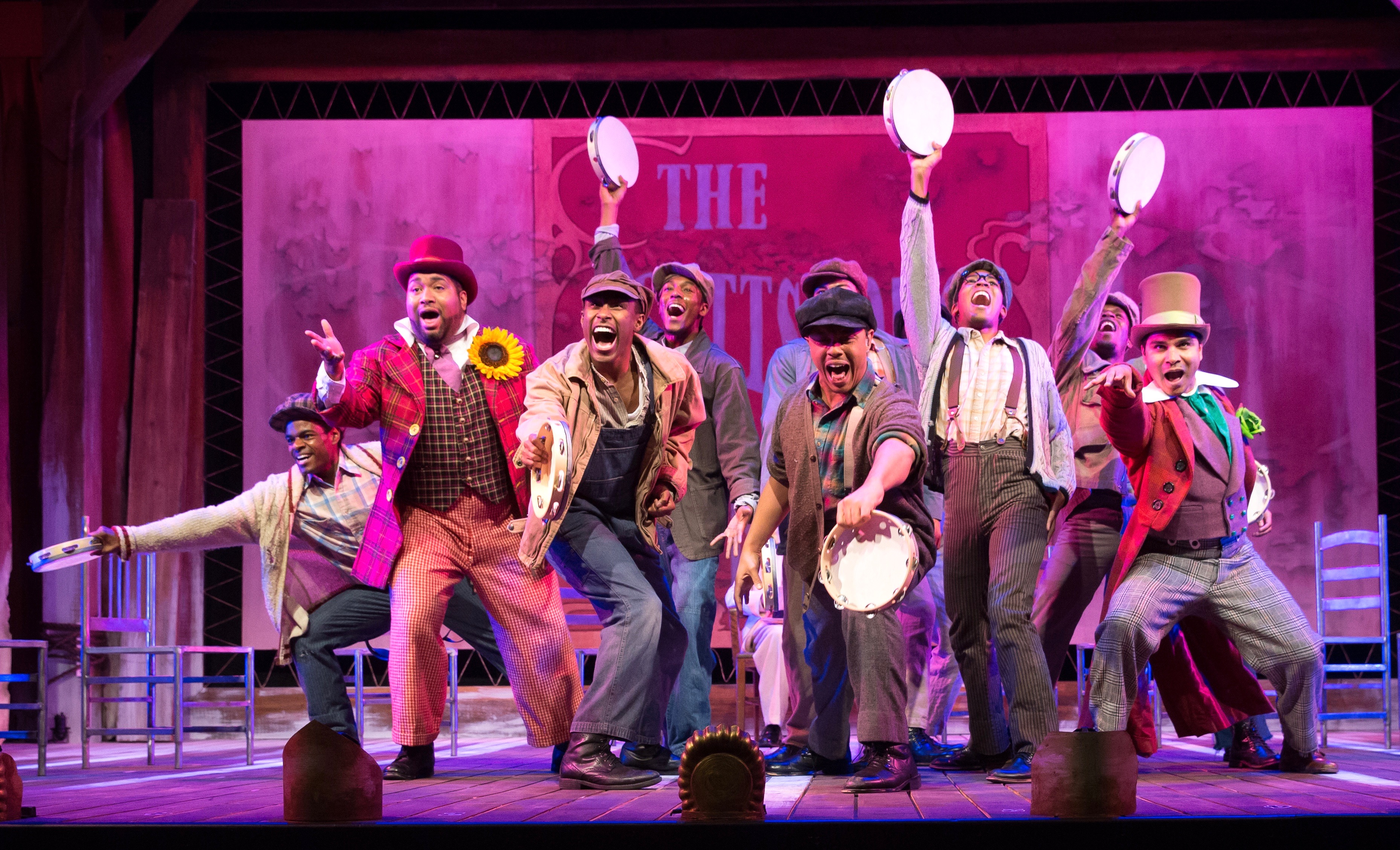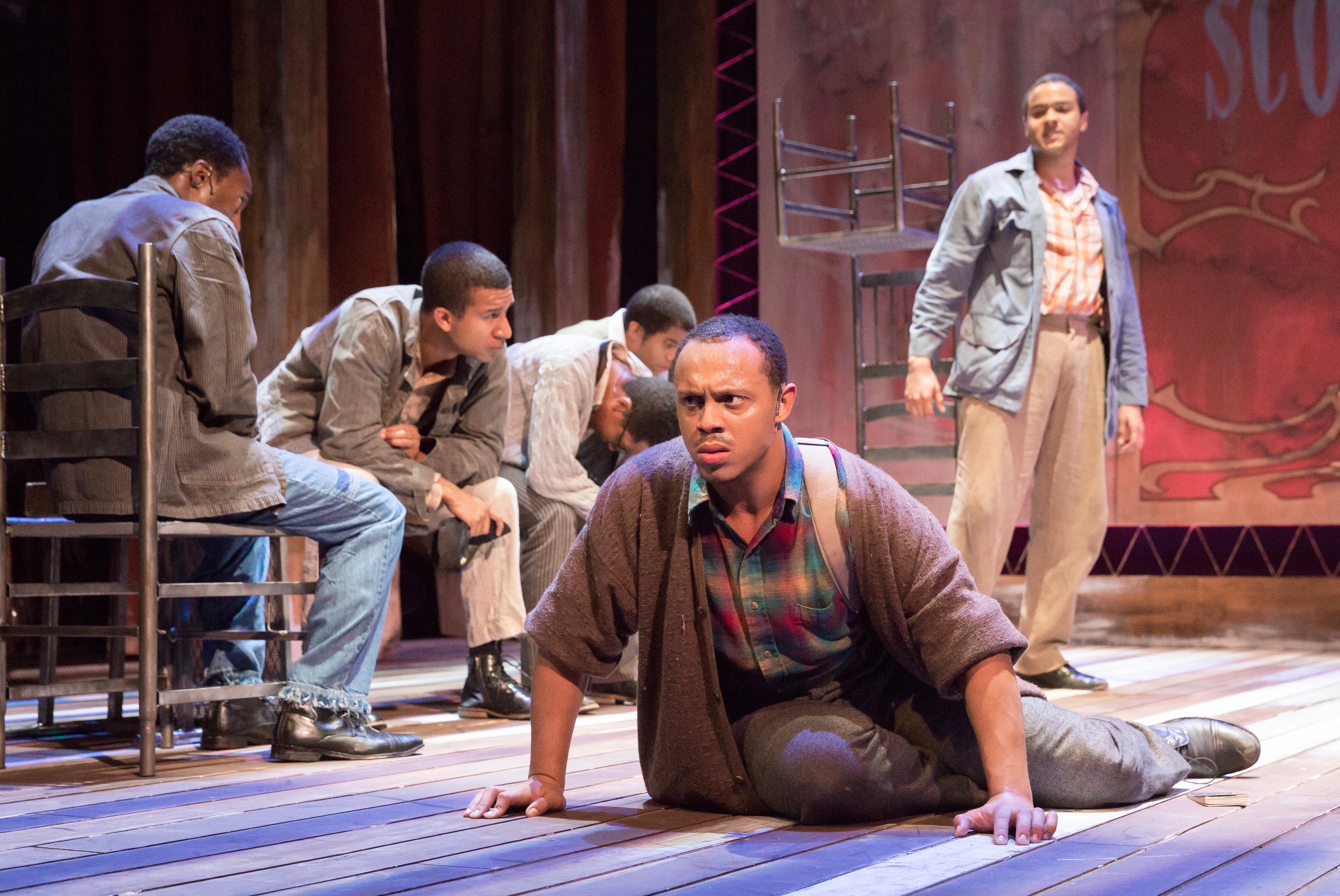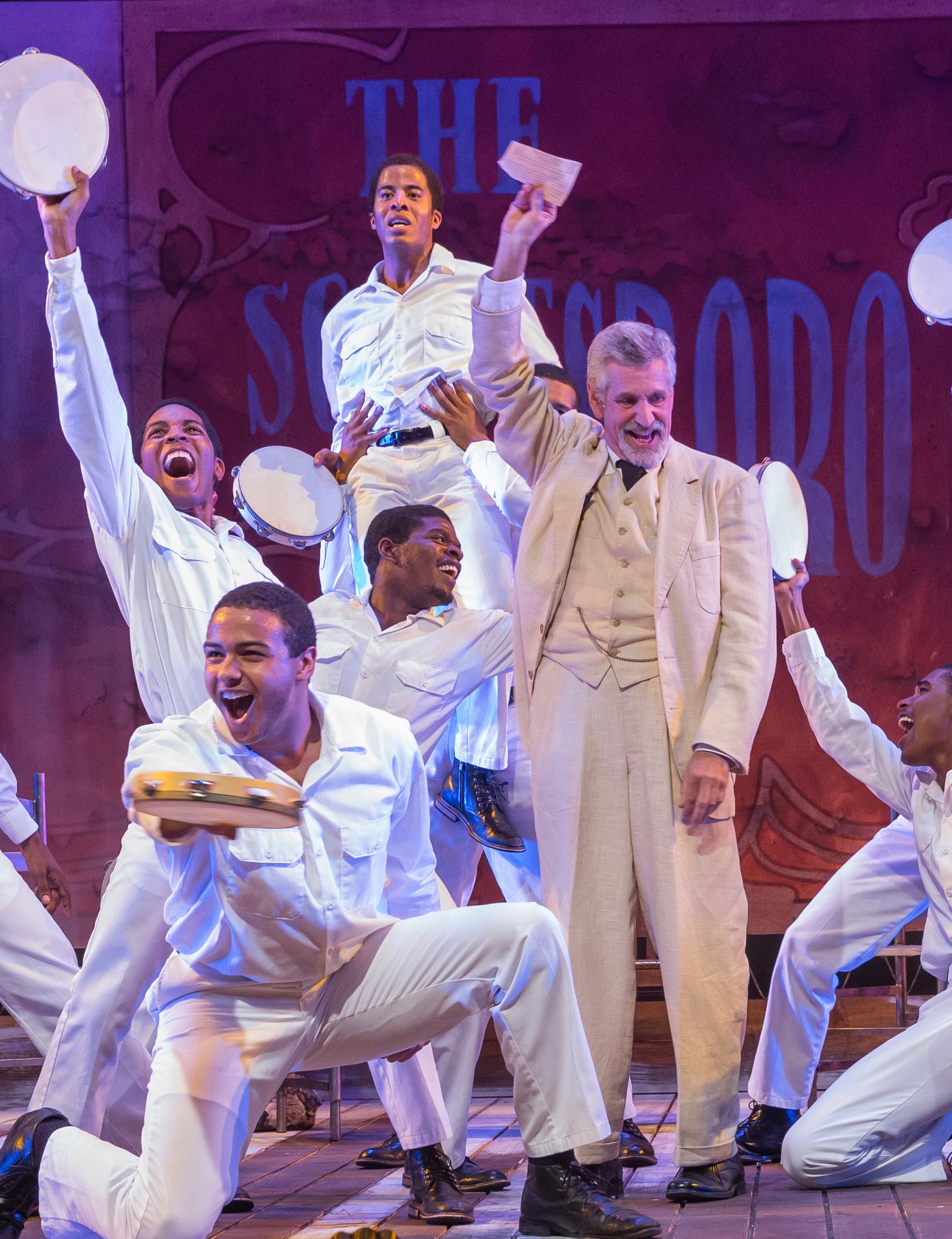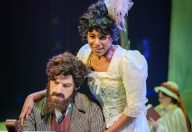Perfect Storm: ‘The Scottsboro Boys’

The musical is almost too good to be true. The story behind it is unfortunately true. The cast does justice to both.
You have a choice. You can see The REP’s production of The Scottsboro Boys (through Sept. 24) at Pittsburgh Playhouse. Or you can smack your head later when people tell you what a great show you missed. I am here to try to help you make the right choice.
It won’t be easy. This musical is brilliant in so many ways that I can’t give you a simple, bumper-sticker summary. “Awesome”? “Spellbinding”? True, but too trite, and too vague. The brilliance lies in the show’s ability to cast multiple spells, dazzling the senses with sheer artistry while it boggles the mind and emotions by turning an ugly true story into a spectacle that’s over-the-top zany and insidiously moving at the same time.
Paradoxical? Definitely. The Scottsboro Boys has been drawing strong—and often contradictory—reactions since its New York premiere in 2010. For instance, critics of the show have said it trades in offensive stereotypes, particularly in the parts where black actors prance through minstrel-show routines, flashing the wide eyes and beaming grins that practically scream “C’mon folks, throw us a few pennies.” Plus we’ve got white Southerners depicted as snarling racists, and, among other things, a song about “Jew money.”
But the minstrel-show numbers are meant as satire. The true story behind the musical is, in fact, a story of vicious racism and injustice in the South during the 1930s. And when nine young black men were tried and convicted on trumped-up charges, a prosecutor really did tell the jury that “Jew money” was behind attempts to free them. Fans of The Scottsboro Boys say it’s a vivid reminder of the racism and injustice still present in our country today.
If that gives you reason enough to attend, excellent. But if you’re one of those inclined to skip it for the same reason, figuring that you don’t need to hear that message another time and you’d rather just experience good theater, I would repeat: This is more than good theater. This is theater magic.
The Backstory
What happened to the real-life Scottsboro Boys wasn’t magical at all. In 1931, these nine teenagers and youth were doing what many did in the early Depression, hopping freight trains and hobo-ing across the country. Stopped by the sheriff at Scottsboro, Alabama, they were charged with raping two young white women who’d been riding the same freight. A local doctor couldn’t find physical evidence of rape. There were strong signs the women had made up the story. Yet the “boys” were rushed one-by-one through perfunctory trials and given the then-maximum sentence: death
Word of their plight spread North. Activist groups found a proper defense lawyer to mount appeals, which kept the defendants from the electric chair. But, despite a long series of re-trials that shot holes in the case against them, the verdicts kept coming back guilty. All of the nine served substantial hard time and didn’t exactly go on to happy lives afterward.

Scottsboro Boy Haywood Patterson (Tru Verret-Fleming) hits bottom.
Making a musical from the grim tale proved a long process as well. Composers John Kander and Fred Ebb (Cabaret, Chicago) took on the challenge late in their careers, along with playwright David Thompson and director-choreographer Susan Stroman.
The Scottsboro Boys only reached the stage after Ebb had died. It set an odd record—most Tony Award nominations without winning any (12)—though it won other big awards. And though some regional productions in other cities have struggled to juggle the show’s tricky elements, The REP, Point Park University’s professional company, does a lights-out tremendous job.
Show Time
The script frames the story as a show within the show. A high-falutin’, spiffily dressed white emcee/ringmaster (played by Marc Moritz) has a motley troupe of black performers, and tonight, he promises, they’re gonna give you a real treat: they will act out the saga of the Scottsboro Boys!
From there, the irony begins to flow—so thickly, in the opening mock-vaudeville sequence, that I feared I was in for a heavy-handed moralistic beating about the eyes and ears. Then came the second musical number, “Commencing in Chattanooga.” Here, the gifted ensemble re-enacts the breezy joy of climbing aboard a freight train headed for rattling good times. The guys do this with just a line of prop chairs to represent the freight cars, but wow, do they make it work. They had me with them on that train. The magic was kicking in.
After that, of course, things turn worse for the characters. So much worse, in places, that here’s a trigger warning for anyone who has been a victim of racial or ethnic violence: you will see some brutal stuff. And for everyone: be prepared to enter the paradox zone, where agonizing material becomes beautiful theater.
In the “Electric Chair” song, two prison guards show one of the boys what he can expect. And while they cackle gleefully about the effects of the treatment—how it fries your eyeballs till they pop out, etc., etc.—a mesmerizing dance unfolds. Two more actors, dressed all in white, play blacks who’ve been electrocuted. They glide about the scene in an electric trance-dance. Their heads are lolled down; you can’t see their faces. They are depersonalized. They’re dead men dancing.
Throughout the show, haunting pieces are interspersed with wacky bits and loony tunes. Real-life court records show that one of the women who had claimed to be raped later recanted her testimony. Apparently she and her friend were suspected of being prostitutes and had used the rape accusation to divert the cops. The musical has the woman explain this in a jaunty song, which starts: “A girl who finds she’s not a looker / may decide to be a hooker …”

The tambourine men play a song for Marc Moritz.
Both women are played by men who also play Scottsboro Boys, Lamont Walker II (the recanter) and Jared Smith. Wearing but minimal drag, they sell the parts utterly. Further, except for Moritz the ringmaster, white characters are likewise played by African-American actors stepping temporarily out of their Scottsboro Boy roles: the sheriff (Billy Mason), the defense lawyer (J.R. Whittington), and so on. As a white person I can testify that they know how to do whiteness.
One Scottsboro Boy, Haywood Patterson, is the musical’s central character. Playing the role is Tru Verret-Fleming, who never shifts into white mode but must shift emotional gears constantly, carrying a lot of the story’s ups and downs. He’ll take your heart along for the ride.
Meanwhile, the irony abounds and rebounds. There’s a scene in which the Boys are languishing in jail, too numbed to respond when they learn they’ve been granted a re-trial. Moritz hollers “Show some gratitude, boys. Slap those tambourines!”—and they’re off into another song and dance.
I saw The Scottsboro Boys on preview night. Supposedly, that’s when the kinks are being worked out. If there were any, I missed them, and if performances to come are even better, holy mackerel.
Closing Credits and Ticket Info
Kander and Ebb’s The Scottsboro Boys is directed for The REP by Tomé Cousin. Choreography is by Cousin and Jeremy Czarniak, with guidance from original choreographer Susan Stroman. May the Great Mackerel forgive me for not yet mentioning the rest of the actors: Steven Etienne, Joseph Fedore, Jonathan Blake Flemings, Ivy Fox (in a secret role), Scott Kelley, Tony Lorrich II, and Latrea Rembert, who is also dance captain.
Music director is Douglas Levine; sound design, Steve Shapiro; scenic design, Britton Mauk; costumes, K.J. Gilmer, and lighting, Andrew David Ostrowski. Through Sept. 24 in the Richard Rauh Theatre at Pittsburgh Playhouse, 222 Craft Ave., Oakland. For times and tickets, visit The REP on the web or call 412-392-8000.
Photos by John Altdorfer.
Mike Vargo, a Pittsburgh-based freelance writer, covers theater for Entertainment Central.
Share on Social Media
Follow Entertainment Central
Latest Stories
Sign up for the EC Newsletter







